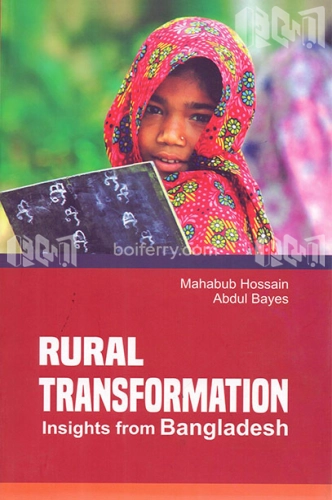The main objective of writing this book is to fill-in the existing research gaps through developing a livelihood strategy framework. In other words, we would like to derive some insights from the process of transformation, and the impacts of such transformation on income and poverty of rural households. But that is easier said than done. What is needed most in this respect is to acquire knowledge about the nexus between the farm sector and the non-farm sector, and how the linkages affect rural livelihoods. In doing so, we have selected four periods over the last two decades (1988; 2000, 2008 and 2014), and repeatedly collected information on socio-economic and demographic indicators for sample households in 62 villages spread over Bangladesh.
It is, perhaps, the first book in the history of Bangladesh that attempts to focus on the identification of the livelihood patterns of the same sample households in four periods. However, while writing this book, we had in mind different types of readers. We thought that the policymakers and the donors who frame policies or place funds might benefit from reading such a book.
Additionally, beneficiaries of this book could be the teachers and the students of colleges and universities who are always engaged in studies related to rural areas. And finally, researchers on rural economy, especially on agricultural economics, might find this book worth its price.
Contents
List of Tables, Figures, and Boxes
Foreword
Preface
*Part 1: The Book and the Livelihoods
*Chapter 1 Introduction
1.1 Background
1.2 Beauty of the Book
*Chapter 2 A Framework of Livelihood Strategy
2.1 Analytical Approach to Livelihoods
2.2 The Transforming Structure and Process
2.3 Theory for Empirical Analysis
Part 2: Resource Endowment and Accumulation
*Chapter 3 Dynamics of Rural Demography
3.1 Introduction
3.2 Households and Population
3.3 Age Pyramid
3.4 Women and Children
3.5 Distribution of Households
3.6 Dependent and Working Age Population
3.7 Occupational Distribution of the Labor Force
*Chapter 4 Rural Health Scenario
4.1 Introduction
4.2 Health Status
4.3 Morbidity 5
4.4 Types of Diseases
4.5 Sources of Treatment
4.6 Treatment Costs
4.7 Concluding Remarks
*Chapter 5 Education: Human Capital Development
5.1 Introduction
5.2 Education in Rural Bangladesh 5.3 Coverage of Educational Institutions by Economic Status
5.4 Education and Occupation
5.5 Education Level
5.6 Results
5.7 Concluding Remarks
*Chapter 6 Agrarian Structure and Assets
6.1 Land-People Nexus: Natural Capital
6.2 Land Ownership and Tenancy Arrangements
6.3 Quality of Land
6.4 Livestock Assets
6.5 Accumulation of Physical Capital
6.6 Access to Institutions and Financial and Social Capital
6.7 Changes in the Endowment of Assets
6.8 Conclusion: Hands on, not off
Part 3: Livelihoods Strategy
*Chapter 7 Patterns of Labor Use: A Time-Budget Approach
7.1 Introduction
7.2 Labor Force Participation by Gender
7.3 Participation of Labor Force by Age Group
7.4 Educational Levels and Duration of Work
7.5 Participation by Land Ownership
7.6 Nature of Employment
7.7 Types of Employment
7.8 Contribution to Total Employment
7.9 Market and Employment
7.10 Underemployment and Socio-economic Status
7.11 Employment by Poverty Status
*Chapter 8 Land Utilization, Cropping Pattern and Cropping Intensity
8.1 Introductory Remarks
8.2 Distribution of Cultivated Land
8.3 Land and Crops
8.4 Cropping Pattern and Cropping Intensity
8.5 Yield of Crops
8.6 Modern Paddy and Crop Diversity
*Chapter 9 Migration: Push or Pull?
9.1 Overall Context
9.2 Migration and Bangladesh
9.3 Migratory Profile
9.4 Migration and Education
9.5 Migrants and Their Distribution
9.6 Profile of a Single Female Migrant
*Chapter 10 Rural Women at Work
10.1 Introduction
10.2 Earlier Studies
10.3 Women and Economic Activities
10.4 Reasons for Women's Participation
10.5 Women's Work and Empowerment
10.6 Conclusions and Policy Implications
* Chapter 11 Nonfarm Economy and Livelihoods
11.1 Preliminary Remarks 273
11.2 Bangladesh Perspective
11.3 Features of Nonfarm Activities
11.4 Strategies and Policies
Part 4: Resource Transformation
*Chapter 12 Modern Technology in Paddy
12.1 Introduction
12.2 Production and Modern Varieties
12.3 Institutions for Rice Research
12.4 Release of Varieties
12.5 Classification of Varieties
12.6 Adoption and Technological Progress
12.7 Replacement of Varieties
12.8 Adoption, Factor Payments, and Efficiency
12.9 Determinants of Adoption: Regression Results
*Chapter 13 Rural Markets and Livelihoods
13.1 Setting the Rationale
13.2 Land Market
13.3 Tenancy Market
13.4 Labor Market
13.5 Credit Market
13.6 Water Market
13.7 Product Market and Prices
13.8 Conclusion
*Chapter 14 Marketing of Crops
14.1 Role of Marketing
14.2 Farmers and Crops
14.3 Incidence of Marketing
14.4 Marketable Surplus
14.5 Story about Stocks
14.6 Farm-Gate Prices
14.7 Harvest Sales
14.8 Why is the Price of Rice Important?
*Chapter 15 Rural Credit Market and Microcredit
15.1 Introduction
15.2 Objectives, Methodology, and Data Sources
15.3 An Overview of the Rural Credit Market
15.4 NGOs and the Microfinance Revolution
15.5 Financial Inclusion
15.6 A Successful Agricultural Credit Program
15.7 Concluding Remarks
*Chapter 16 Infrastructure: Gateway to Growth!
16.1 Defining Infrastructure 421
16.2 Review of Research 421
16.3 Theoretical Construct 424
16.4 Impact of Infrastructure in Bangladesh 427
16.5 Infrastructure and Poverty 435
16.6 Infrastructure and Inequality 436
16.7 Infrastructure and Poverty: Perceptions 437
Part 5: Livelihood Outcomes
*Chapter 17 Costs, Returns, and Crops
17.1 Introduction
17.2 Use of Inputs
17.3 Cash and Unit Costs
17.4 Changes in Output and Input Prices
17.5 Costs and Returns in Cultivation
17.6 Mechanization and Costs
17.7 Contribution of Factors and Productive Force
17.8 Farm Size and Productivity
*Chapter 18 Household Income: Growth, Structure and Disparity
18.1 Methodological Niche
18.2 Income Growth and Structure
18.3 Determinants of Income
18.4 Nature of Income Distribution
*Chapter 19 Household Expenditure Patterns
19.1 Introduction
19.2 Rural Food Demand Structure
19.3 Measurement Issues
19.4 Findings
*Chapter 20 Poverty: Measurement, Trend and Determinants
20.1 Introduction
20.2 Measurement of Income Poverty
20.3 Problems in Determining the Poverty Line
20.4 Changes in Income-Poverty: Quantitative
20.5 Changes in Income Poverty: Qualitative
20.6 Profile of the Poor
20.7 Research and Perceptions of the Poor
20.8 People's Perceptions of Economic Change
20.9 Non-Income or Human Poverty
20.10 Persistent and Transient Poverty
20.11 Livelihood Strategy for Escaping Poverty
20.12 Conclusion: The Gun of Growth
*Chapter 21 A Tale of Transformation
21.1 A Different Village
21.2 Similar but not Same
21.3 Of Heroes and Villains
21.4 Transforming Agrarian Structure
21.5 Transforming Power Structure
21.6 How are Rural People?
21.7 Concluding Remarks
Index
আবদুল বায়েস এর Rural Transformation : Insights from Bangladesh এখন পাচ্ছেন বইফেরীতে মাত্র 1062.50 টাকায়। এছাড়া বইটির ইবুক ভার্শন পড়তে পারবেন বইফেরীতে। Rural Transformation : Insights from Bangladesh by Abdul Bayesis now available in boiferry for only 1062.50 TK. You can also read the e-book version of this book in boiferry.















